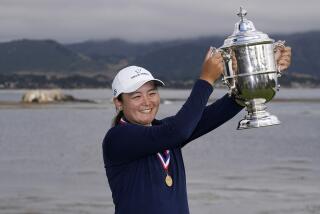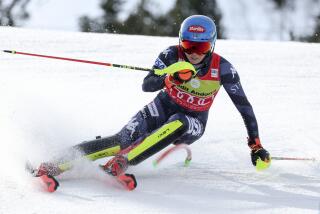With Graf, It’s Case of Best Getting Better
- Share via
Steffi Graf is preposterous. The rest of women’s tennis can only gape at her massive, injurious strokes and accomplishments, one Grand Slam won and another already being discussed.
There have been various suggestions as to how to cure her dominance at the Virginia Slims of Washington, Carling Bassett Seguso intimating Graf should join the men’s tour, and a spectator putting forth the notion she should play left-handed.
Prayer is always nice.
Or they can wait for those rare occasions when she runs a temperature. She rules the game for a 72-3 record last season, seeming impossible to duplicate until she opened 1989 with a laughably easy defense of the Australian Open for her fifth consecutive Grand Slam title.
“She’s alone,” CBS analyst Mary Carillo said. “Anybody who might be in her way is too nauseous. That’s what she’s done to them.”
Graf, at 19, is getting better. “She’s just a kid, she still needs another two years,” her coach, Pavel Slozil, said. “Then they’re going to be in even bigger trouble.”
They are already in a state of emergency. Chris Evert is merely fodder for Graf’s lethal groundstrokes.
Even Martina Navratilova now seems overwhelmed by the teen-age insurgent. Gabriela Sabatini and Pam Shriver have the most recent victories against her--when she was sick.
Evert has said the only thing that can stop her is “boredom.” Players are laboring in the weight room and on the practice court, trying to catch up.
“She’s beating everyone quite badly,” said Manuela Maleeva, the third seed who at No. 7 is the highest-ranked player other than Graf in the Slims of Washington field. “The motivation is, to not to be one of these that loses to her so easy. To stay with her a little.”
Bassett Seguso, flicked from the sleeve of Graf by 6-0, 6-0 last week, predicted: “No one will beat her this year.” Natalia Zvereva of the Soviet Union, the No. 8 player in the world, is on course to meet Graf in the semifinals, but is frank in assessing her chances. “I am not ready to beat her,” she said. “Every person is not 100 percent, so maybe she has a weakness. But I don’t know what it is.”
One would think this dearth of threatening opponents would indeed bore Graf. But it has not slowed her at all, and that perhaps is the key to this phenomenon, that she is one of the most ambitious players to ever play the game. “If I didn’t have goals, it wouldn’t be interesting,” she said. “I try to please myself.”
Both baseliners and serve-and-volleyers have been equally unavailing against a rounded game that displays no evident vulnerability. Only the three defeats in the last year show it can be done: Sabatini upset her at the Virginia Slims of Florida, 2-6, 6-3, 6-1, when Graf suffered from jetlag; and again more convincingly at Amelia Island on clay, 6-3, 4-6, 7-5.
Graf protests, “You can always lose, it’s always a possibility.” But this is because she is human. Sabatini’s deep, heavy topsin does seem to bother Graf, mainly because it forces her 10 feet further from the baseline, and there her shots lack some of their usual power. Or a sharp serve-and-volleyer on a good day, while Graf has a bad one, will make her vulnerable. Shriver’s semifinal victory at the Virginia Slims Championships in November was gallant, 6-3, 7-6 (7-5), but Graf had a head cold.
In searching for a technical weakness in Graf, one can only nitpick. Her forehand is not a perfect illustration; she makes contact with the ball somewhat late, almost parallel to her body. While it might be preferable to meet the ball earlier, her physical strength is such that it doesn’t matter, and in her case might be an asset because it makes her stroke harder to read.
“Her technique is not textbook,” said Barbara Potter, the 12th-ranked player who is regarded as a student of the game. “But neither was John McEnroe’s serve or Bjorn Borg’s forehand.”
It has often been said that Graf’s backhand is a weaker shot, slightly less reliable than the forehand. But in the last year she has developed the ability to hit either a consistent hard slice or crushing topspin, and now that remark evokes gales of laughter from analysts. “Compared to what?” Carillo said. “Her forehand? Yeah, it’s not her forehand. Because nothing is her forehand.”
Mainly opponents must contend with Graf’s furious pace. At 5 feet 9 and 132 pounds, she is among the hardest hitters the game has ever produced; harder than Navratilova, some suggest. Only Sabatini, Helena Sukova and Claudia Kohde-Kilsch can match her on some strokes, but not consistently. In response Sabatini has tried to build up, adding strength to her shoulders. But this could limit her flexibility and mobility.
“There’s a difference between strength and power,” Carillo said. “Sabatini can lift a couch. Steffi can throw the couch across the room. That’s the difference.”
There is one phase in which the other women players cannot hope to approach equality with Graf, and that is her pure instinct for the game. Her movements are almost as biomechanically correct, with an anticipation that Potter estimates begins as soon as the ball is eight feet from the strings of her opponent’s racket.
It starts in her quick firing legs, which have not the slightest bit of fat. She has an inexhaustible energy level for practice and training, “She’s almost antsy,” Potter said. Partly this comes from a discipline that is found nowhere else on the women’s tour. She doesn’t indulge in nightlife and likes to be in her room by 9 p.m.
“There is something special inside her, she’s doing it for herself,” Slozil said. “She needs tennis. Her body needs to run.”
It is widely acknowledged that Navratilova is the only player with the physical prowess and discipline to defeat Graf consistently. But the former No. 1 player in the world has made just one final in the last five Grand Slam events, and that was a defeat to Graf, 5-7, 6-2, 6-1.
Quite apart from Graf’s physical attributes, she is beginning to exert an intangible mental block on other players. Potter thinks a common mistake her opponents make to try to hit shots they can’t make, “to search for a game they don’t have.”
There have been extended periods of domination before, by Evert in 1974 when she won 55 consecutive matches, and Navratilova in 1984, when she went on a 74-match streak without a loss, a record that still stands. But while those were lengthier reigns than Graf’s 46 straight match victories last season, consider Graf lost just two sets in sweeping the Australian and French opens, Wimbledon and the U.S. Open last year and the Australian last month.
More to Read
Go beyond the scoreboard
Get the latest on L.A.'s teams in the daily Sports Report newsletter.
You may occasionally receive promotional content from the Los Angeles Times.










